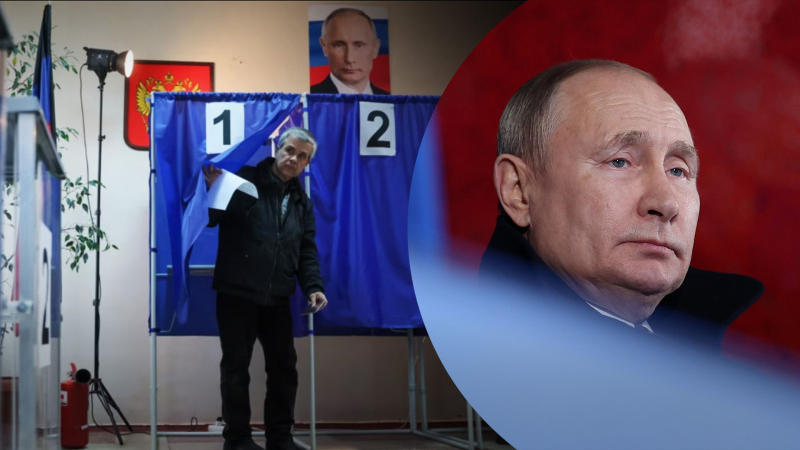The media talked about falsifications/Collage 24 Channel (Photo by Getty Images) The media stated that Vladimir Putin achieved record results in the “elections” with the help of falsifications on an unprecedented scale. After all, the dictator “gained” 87.28% of the votes; at the “elections” the turnout was supposedly 77.44%. Russian journalists said, that they do an analysis based on the CEC website and publicly available data from programmer and electoral analyst Ivan Shukshin, writes 24 Channel. Some of the statistical anomalies that are noticeable in the data from the precinct election commission are quite obviously evidence of falsification, since they cannot be explained by anything else. Others simply look very suspicious, and could in principle be the result of other reasons. In other words, the anomalies are different and should be considered separately, the publication said. However, they point to two main anomalies that are characteristic of many “elections” in Russia in recent years decades: And these indicators in the “elections” in 2024 reached record values. Meduza journalists talked about the method of Sergei Shpilkin, who proposed a way to separate normal voices from fake ones. The exact number of voters who came to the polling stations and the number of votes they cast for different candidates depends on many random factors. Therefore, we can expect that, in general, the distribution of various precinct election commissions (PECs) by turnout and candidate results will be characteristic of random processes, that is, normal, Gaussian, bell-shaped, the publication explained its method. To put it simply, then in a two-dimensional diagram of the distribution of turnout and candidate results, polling stations should look like one symmetrical spot. If deviations appear, then such choices are considered anomalous and require explanation. In Russia there has been no so-called symmetrical spot since 2004. Elections have been increasingly rigged in Russia since 2004/Screenshots from ” Jellyfish” The most obvious explanation for the anomaly, what kind of pro-government candidate is physically they threw ballots into ballot boxes or entered a certain number of ballots into the protocols. Where the ballots were thrown in, the diagram looked like the tail of a comet, which goes to the upper right corner. By the way, journalists noted that the core of normal PECs at the “elections” in 2024 simply disappeared, almost only anomalous areas remained. The second most important anomaly of these and previous elections is the appearance of peaks on round values turnout and result – the so-called “Churov saw,” the publication explained. It noted that this anomaly cannot be explained by anything other than fitting protocols for the desired result. However, there is a small background level due to which peaks in the distributions may arise for purely arithmetic reasons. The reason may be the finite number of registered voters at the polling station. But in fact, peaks on round values first appeared in Russia in the 2004 elections and have only become more pronounced since then. In 2024, areas with falsifications make up the majority /Screenshots from Meduza When comparing the presidential elections of 2018 and 2024, it is important to remember that the level of fraud in 2018 was already so large-scale that their results should be canceled even under Russian law,” the publication noted. After all, in 2008, in more than a third of the polling stations, the “voting” results should have been cancelled. After all, observers who studied records from 1,748 polling stations from 20 regions found that 933 (55%) of them had significant falsifications. A Significance article at the time covering the 2018 election reported 1,708 precincts with rewritten protocols. Now journalists have counted 2898. That is, the number of sites with rewritten protocols has almost doubled. How the number of “dirty” polling stations is growing in Russia/Screenshots from Meduza According to Ivan Shukshin's analysis, there are “thrown in” 22 million votes. He explained that the main instrument of falsification is not even physical stuffing of protocols, but direct rewriting of protocols. ~strong>31.6 million votes. The difference in the calculations is that Shukshin took the spot of 50% of voters in the area of 85% turnout as the norm, and the newspaper journalists took the “Moscow” peak with a turnout of 40%. However, the publication is convinced – both estimates are inadequate, because in Russia there are no longer normal polling stations, from which it would be possible to calculate the real percentage of votes cast for candidates, and, accordingly , get cleared results by taking the completed ones. Analyzing 11 regions with a minimum level of falsification, Shukshin came to the conclusion that allegedly: > “But this approach has its own shortcomings – it is not known how the mood of voters in 11 separate regions reflects the overall level of support for candidates. Therefore, to call these results real, then there are those that would have been published if there had not been falsifications, which is also incorrect,” the publication explained. They also remembered that there should have been elections in 2018 canceled. It can truly be said that the current vote was the most distorted by fraud in Russian history – although the exact number of stolen votes remains unknown, concluded edition.
How Putin’s “elections” were held in Russia
How the “elections” of the dictator have changed dramatically since 2000
What do peaks on round values mean or 2 anomalies in Putin’s “elections”
How many “voices” were completed
The least fair “elections” in Russian history: how the Kremlin rigged “votes” to an unprecedented scale
56

